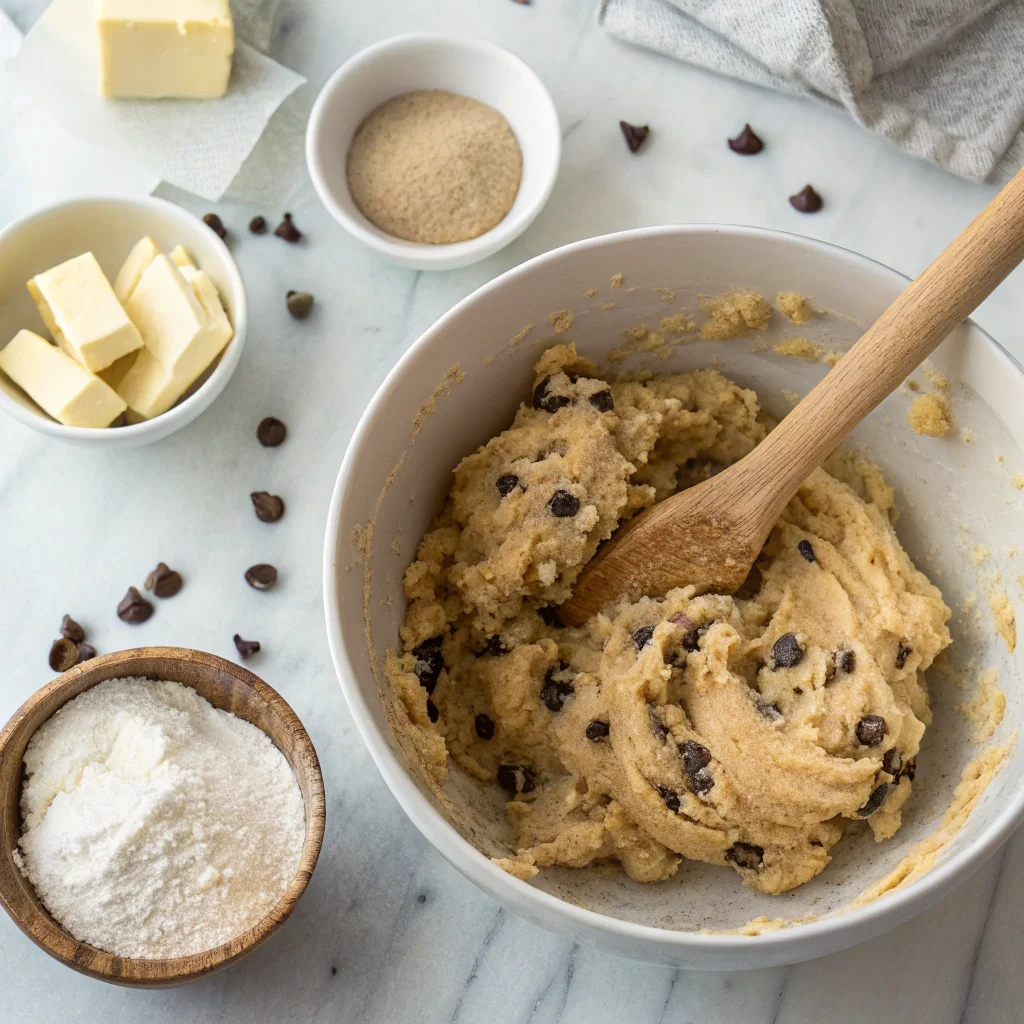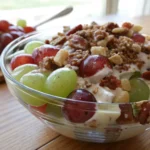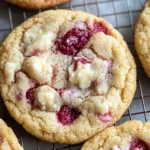Are you out of brown sugar but still craving the comforting taste of homemade chocolate chip cookies? No need to worry! This detailed guide will show you how to make a chocolate chip cookie recipe without brown sugar that delivers the same chewy texture and rich flavor you love. With step-by-step instructions, handy tips, and real-life data, you’ll feel confident baking these cookies for any occasion.
Table of Contents
Why Make Chocolate Chip Cookies Without Brown Sugar?
While brown sugar is commonly used in chocolate chip cookie recipes, there are many reasons to omit it:
- Availability: Sometimes, you simply don’t have brown sugar in your pantry.
- Flavor Variation: Granulated sugar creates a lighter, crispier cookie.
- Customization: Baking without brown sugar allows for more creativity, like adding spices or nuts.
- Health Preferences: Reducing molasses (found in brown sugar) can align with certain dietary choices.
For example, replacing brown sugar with granulated sugar reduces the moisture content, resulting in cookies with a slightly different texture—perfect for those who enjoy crisp edges.
The Ingredients You Need
Before you begin, gather the following essential ingredients:
| Ingredient | Measurement | Purpose |
|---|---|---|
| Granulated sugar | 1 cup | Sweetener and structure |
| Unsalted butter | ½ cup | Adds richness and moisture |
| Large egg | 1 | Binds ingredients and adds moisture |
| Vanilla extract | 1 teaspoon | Enhances flavor |
| All-purpose flour | 1½ cups | Forms the base of the dough |
| Baking soda | ½ teaspoon | Helps the cookies rise |
| Salt | ¼ teaspoon | Balances sweetness |
| Chocolate chips | 1 cup | The star ingredient for flavor |
These ingredients are easily found in most kitchens, and substitutions are possible if needed. For instance, margarine can replace butter, but it may alter the texture slightly.
Step-by-Step Chocolate Chip Cookie Recipe Without Brown Sugar
Step 1: Preheat Your Oven
Set your oven to 350°F (175°C) and line a baking sheet with parchment paper. Proper preheating ensures even baking, a critical step for the perfect cookies.
Step 2: Cream the Butter and Sugar
In a large mixing bowl, combine unsalted butter and granulated sugar. Use a hand mixer or stand mixer to blend until the mixture becomes light and fluffy. This process incorporates air, ensuring your cookies are tender and soft.
Step 3: Add Wet Ingredients
Mix in the egg and vanilla extract. Be sure to scrape down the sides of the bowl to incorporate all ingredients evenly.
Step 4: Combine the Dry Ingredients
In a separate bowl, whisk together all-purpose flour, baking soda, and salt. Gradually add the dry mixture to the wet ingredients, stirring just until combined. Overmixing can lead to tough cookies, so handle the dough gently.
Step 5: Fold in Chocolate Chips

Gently fold in chocolate chips, ensuring they are evenly distributed. If you prefer variety, consider adding white chocolate chunks or chopped nuts for added texture.
Step 6: Scoop and Shape
Use a tablespoon or cookie scoop to portion the dough onto the baking sheet, spacing each scoop about 2 inches apart. This spacing prevents the cookies from merging during baking.
Step 7: Bake to Perfection
Place the baking sheet in the oven and bake for 8–10 minutes. Look for cookies with golden edges and slightly soft centers.
Step 8: Cool and Enjoy
Let the cookies cool on the baking sheet for 5 minutes before transferring them to a wire rack. This cooling time helps them firm up while retaining their soft centers.
Tips for the Best Cookies Every Time
To make your chocolate chip cookie recipe without brown sugar even better, consider these tips:
- Chill the Dough: Refrigerating the dough for 15–30 minutes before baking creates thicker cookies.
- Measure Accurately: Use measuring cups and spoons for precise ingredient ratios.
- Experiment with Add-Ins: Try coconut flakes, peanut butter chips, or dried fruit.
- Avoid Overbaking: Cookies continue to bake on the sheet after removal from the oven, so take them out when the centers are still soft.
Nutritional Information: Understanding the Health Impact of Chocolate Chip Cookies Without Brown Sugar
When making a chocolate chip cookie recipe without brown sugar, it’s important to consider the nutritional profile. While cookies are a treat, understanding their nutritional content can help you enjoy them in moderation without guilt. Below is an in-depth look at the nutrients typically found in these cookies, based on a standard batch yielding 24 cookies.
Per Cookie Nutritional Breakdown
| Nutrient | Amount Per Cookie | Daily Value (%)* | Details |
|---|---|---|---|
| Calories | ~120 kcal | 6% | Provides energy primarily from carbohydrates and fats, making it a quick snack for an energy boost. |
| Total Fat | 6g | 8% | Mostly from butter; includes saturated fats that contribute to the cookie’s rich flavor and texture. |
| Saturated Fat | 3.5g | 18% | Found in butter and chocolate, saturated fat should be consumed in moderation. |
| Cholesterol | 15mg | 5% | Comes from the egg and butter; essential for hormone production but should be limited for heart health. |
| Sodium | 70mg | 3% | Salt enhances flavor but also contributes to sodium intake, important for maintaining electrolyte balance. |
| Total Carbohydrates | 16g | 5% | Includes sugars and starches that provide quick energy. |
| Dietary Fiber | 0.5g | 2% | Chocolate chips add minimal fiber; increasing whole-grain flour could improve this. |
| Sugars | 10g | — | Derived mainly from granulated sugar and chocolate chips. |
| Protein | 1g | 2% | Eggs provide a small amount of protein, essential for muscle repair and growth. |
Ingredient Contributions to Nutritional Value
- Butter:
A primary source of calories and fat, butter also provides fat-soluble vitamins like vitamin A. It enhances the flavor and moisture in cookies. Substituting with margarine or plant-based alternatives can reduce saturated fat but may slightly alter taste and texture. - Granulated Sugar:
Without brown sugar, cookies depend entirely on granulated sugar for sweetness. While sugar provides quick energy, consuming too much can lead to energy crashes. To reduce sugar, consider replacing some with natural sweeteners like stevia or erythritol. - Chocolate Chips:
Chocolate chips are high in sugar and saturated fat but also contain small amounts of antioxidants from cocoa. Using dark chocolate chips with a higher cocoa percentage can lower sugar content and add beneficial flavonoids. - Eggs:
Eggs are rich in protein, vitamin D, and choline. They also help bind the cookie dough together, contributing to the cookie’s structure and softness. - Flour:
All-purpose flour is low in fiber and nutrients compared to whole-grain alternatives. Substituting half the flour with whole-wheat flour can boost fiber and mineral content.
Ways to Modify for Healthier Cookies
To make your chocolate chip cookie recipe without brown sugar more nutritious, try the following:
- Reduce Sugar: Replace half of the granulated sugar with a natural sweetener like honey or maple syrup to lower refined sugar content.
- Add Fiber: Use whole-grain flour or mix in oats to increase fiber, which aids digestion.
- Incorporate Healthy Fats: Swap half the butter for unsweetened applesauce, avocado, or Greek yogurt to reduce saturated fat.
- Use Dark Chocolate: Opt for dark chocolate chips with at least 70% cocoa for lower sugar and higher antioxidant levels.
- Include Nuts or Seeds: Add chopped nuts or chia seeds for healthy fats, fiber, and additional protein.
Calories by Ingredient (Per Cookie)
Here’s a breakdown of where the calories come from in a single cookie:
| Ingredient | Calories | Percentage of Total Calories |
|---|---|---|
| Butter (½ cup) | 45 | 37.5% |
| Granulated Sugar | 40 | 33.3% |
| All-Purpose Flour | 20 | 16.7% |
| Chocolate Chips | 12 | 10% |
| Egg (1 large) | 3 | 2.5% |
Portion Control and Serving Tips
While cookies are an indulgence, practicing portion control can help balance enjoyment and health:
- Stick to One Cookie: Limit yourself to one or two cookies per serving to keep calories in check.
- Pair with Protein: Enjoy cookies with a glass of milk or a handful of nuts to slow sugar absorption and maintain energy levels.
- Bake Smaller Cookies: Use a smaller cookie scoop to reduce portion size while still enjoying the treat.
By understanding the nutritional content of your chocolate chip cookies without brown sugar, you can make informed decisions about how to enjoy them as part of a balanced diet.
Frequently Asked Questions
What can I use if I don’t have brown sugar for chocolate chip cookies?
If you don’t have brown sugar, you can substitute it with granulated sugar in equal amounts. Adding a tablespoon of molasses to granulated sugar mimics the flavor of brown sugar. Other options include coconut sugar, honey, or maple syrup, though these may slightly alter the texture and sweetness of the cookies.
“If you’re looking for a traditional chocolate chip cookie recipe, this Hershey’s chocolate chip cookie recipe is another great option to try.”
What happens if you don’t put brown sugar in cookies?
Without brown sugar, cookies will have a slightly crispier texture and a lighter color. Brown sugar contains molasses, which adds moisture and a caramelized flavor. Using only granulated sugar creates a firmer cookie with a more straightforward sweetness.
Is brown sugar necessary for baking cookies?
Brown sugar is not essential for baking cookies, but it contributes to a chewy texture and deeper flavor. Many recipes can be adapted by replacing brown sugar with granulated sugar or other sweeteners. Adjust the wet-to-dry ingredient ratio if needed to maintain the desired texture.
What is the secret ingredient to keep cookies soft?
The secret ingredient to soft cookies is cornstarch. Adding 1–2 teaspoons to the dry ingredients creates a tender, soft texture. Additionally, using more brown sugar than granulated sugar or incorporating cream cheese can enhance softness.
How do bakeries keep their cookies soft?
Bakeries use a combination of techniques to keep cookies soft:
- Chilling the dough before baking to control spread.
- Baking at a slightly lower temperature to retain moisture.
- Using ingredients like brown sugar, butter, and eggs that contribute to a soft texture.
- Storing cookies in airtight containers with a slice of bread to maintain moisture.
What is the trick to making soft and chewy cookies?
The trick to achieving soft and chewy cookies lies in these steps:
- Use more brown sugar than granulated sugar for added moisture.
- Bake the cookies until the edges are set but the centers are slightly underbaked.
- Incorporate egg yolks for richness and a soft texture.
- Avoid overmixing the dough to prevent tough cookies.
By following these tips and substitutes, you can create cookies that are irresistibly soft and flavorful, even without brown sugar!
Pro Tips for Perfecting This Recipe
To ensure your chocolate chip cookie recipe without brown sugar is flawless, follow these advanced techniques:
- Use room temperature ingredients for easier mixing.
- Test a single cookie before baking the entire batch to adjust oven temperature or bake time.
- If your dough feels too dry, add a tablespoon of milk to achieve the desired consistency.
“For more ideas on enhancing your chocolate chip cookies, explore these proven tips for chocolate chunk desserts.”
Conclusion
This chocolate chip cookie recipe without brown sugar is a hit for all bakers. It uses white sugar instead, making the cookies just as tasty but with a unique texture. Many people love this difference.
We’ve shown you how to make these cookies in this guide. You’ll learn about the ingredients, tools, and steps to make them perfect. You’ll get tips on portioning dough and achieving the right texture.
Baking is all about trying new things and making each batch special. You can try different variations or come up with your own flavors. Either way, you’ll make something delicious that will please everyone.
So, get your oven ready and start baking. Your home will soon smell amazing with the scent of chocolate chip cookies. Enjoy every bite and feel proud of what you’ve made.
“For the ultimate indulgence, enjoy your freshly baked cookies with a glass of milk—check out this classic cookie and milk pairing guide for tips.”





